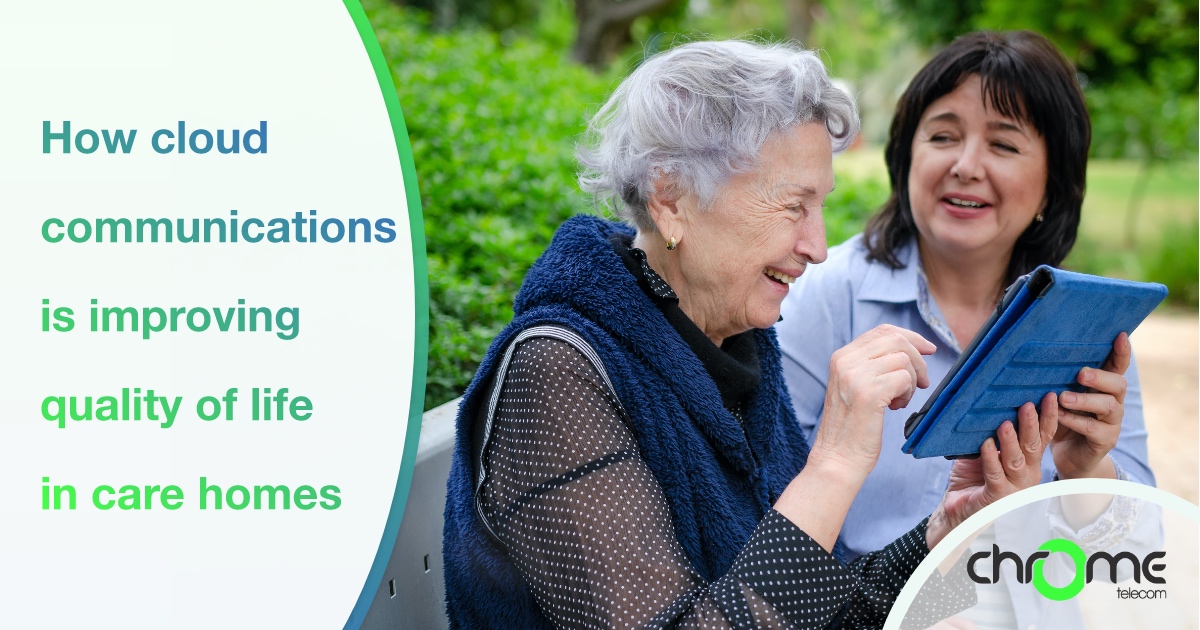Cloud systems, and technology in general, are maybe not what you’d normally associate with care homes.
This has been changing recently. Residents are making far greater use of technology in their day-to-day lives than ever before. This has created a huge improvement in the quality of life in care homes. In this blog post we will explore the benefits of cloud technology to care homes, from resident comfort to patient outcomes and operational efficiency.
It starts with bandwidth.
Care home residents have different expectations today compared to as little as a decade ago. For comfort, ease of transition and perhaps most importantly continued independence, it’s important to provide residents with the same comforts of their own home.
Until fairly recently, providing enough bandwidth for all your residents to stream movies, make video calls and shop online was difficult and costly. Speeds of broadband connections have increased massively in the last decade, however. We are now at the point where a single FTTP or even G.Fast connection is capable of supporting dozens of residents alongside the use of cloud tools in your business.
The gigabit speeds of an FTTP connection, for example, is enough for forty simultaneous 4K Ultra HD Netflix streams. You may be surprised at the speed of the connections we can provide to you. If your care home’s internet connection could do with an upgrade, get in touch with us at Chrome and we’d be more than happy to help.
Stay positive!
Throughout lockdown, video conferencing was a lifeline for care home residents to the outside world. Being able to stay in touch with loved ones has done wonders for the mental health of care home residents around the country, helping recovery and combatting loneliness.
Now that video calling facilities are commonplace in care homes, they are not going anywhere. Obviously they are no replacement for face-to-face visits, but they allow residents to stay in touch with friends and family around the world.
The effect that video calling has had on positivity among residents and patients is remarkable. We’ve been lucky enough to work with care homes throughout lockdown, and it’s always great to hear stories from our clients about residents using technology.
Re-think your wireless network.
A strong WiFi connection is crucial. Traditionally this has presented some difficulties to care homes, particularly those using converted buildings. As ever, modern technology can provide the solution. The latest mesh networks extend wireless coverage to every corner of even the oldest buildings. This ensures that every resident has access to a fast wireless connection.
Mesh networks are inherently more reliable and easier to maintain than more traditional networks, giving you built-in redundancy. If any access point drops offline, others step in to take over, maintaining a strong connection with all devices.
With a strong wireless signal, it becomes easy to make sure that residents can contact their friends and families from their own rooms. We’ve got a lot of experience dealing with the unique challenges of installing wireless networks in care homes. Our wireless systems are cost-effective, reliable, simple to use and expand.
Protect residents while encouraging independence.
The days of residents waiting their turn for phone calls are over. The ease of setting up new lines and separate billing makes it easier than ever to provide private phone lines to each resident. This is just one of the changes VoIP and the Cloud are bringing to the residential care space.
VoIP phone systems are simpler to configure, use and maintain than their analogue equivalents. They also make safeguarding vulnerable residents far easier. For example VoIP systems can run on a “whitelist” basis, protecting residents against unwanted and potentially malicious cold-calling.
Private phone lines promote the independence and privacy of your residents, but in doing so they can also save your staff a huge amount of time screening incoming calls. These settings can be enabled on a per-user basis, allowing care home operators to customise the levels of protection each resident receives. With our Cloud VoIP systems, safeguarding your most vulnerable residents doesn’t have to limit their independence.
Transform care by improving communication.
Cloud communications help care home operators and medical staff deliver a more efficient care service. Video appointments with doctors have become the norm over the last year, for obvious reasons. This looks set to continue, too; a video meeting with a doctor is far quicker and less stressful than travelling to a surgery and waiting to be seen.
Care home operators, residents and clinical staff alike are benefitting from this move towards cloud technology. Video calls are far easier for care home operators to support and arrange than face-to-face meetings, particularly during a pandemic. Seeing a doctor from the comfort of their own room is a fantastic benefit for residents. This makes the process far easier; with no need to travel or wait in a line to see a doctor, residents will tend to seek medical attention sooner.
Of course, remote diagnosis is not a long-term replacement for all face-to-face meetings, but it is a fantastic way for patients to get seen sooner.
By now it’s clear that the intelligent use of Cloud communications can create an enormous improvement in the quality of life of care home residents. Cloud systems help residents maintain independence without impacting safeguarding. They can help you improve your care levels while reducing costs.
We’ve been working with care homes around the country throughout lockdown. Our engineers have got a huge amount of experience working in sensitive areas, and follow all Covid guidelines to maintain safety. If you operate a care home and are looking to upgrade any of your communications tools, get in touch. We’re more than happy to arrange a Covid-safe meeting or a free video consultation.
Give us a call on 03333 212 707 to get started.
